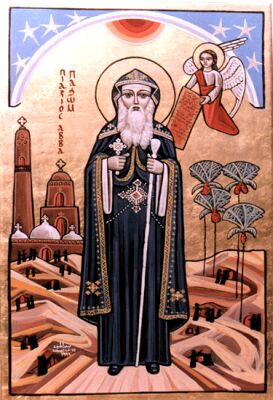Difference between revisions of "Pachomius the Great"
(→Life) |
|||
| Line 8: | Line 8: | ||
He remained the father of the Cenobites for forty years. When the time of his departure drew near (he died during a plague in Tabenna), he called the monks, strengthened their faith, and appointed someone to take over his place after him, then departed in peace. At the time of his death, he was the spiritual leader of about 3,000 monks. | He remained the father of the Cenobites for forty years. When the time of his departure drew near (he died during a plague in Tabenna), he called the monks, strengthened their faith, and appointed someone to take over his place after him, then departed in peace. At the time of his death, he was the spiritual leader of about 3,000 monks. | ||
| − | St. [[Jerome]] translated the rule of St. Pachomius into Latin in 404, and only this translation survives. The rule of St. Pachomius influenced St. [[Benedict]] in preparing his own rule for monks in the West. | + | St. [[Jerome]] translated the rule of St. Pachomius into Latin in 404, and only this translation survives. The rule of St. Pachomius influenced St. [[Benedict of Nursia|Benedict]] in preparing his own rule for monks in the West. |
==Sources== | ==Sources== | ||
Revision as of 12:29, August 21, 2005
Life
St. Pachomius was born in 292 A.D. in Thebes (Luxor) from pagan parents, who forced him to worship idols. He rejected and mocked this worship. He was a soldier before his baptism in 314 A.D., then became a monk in 317 A.D. with St. Palaemon (Balamon). He lived in submission to him for many years, and he mastered well the ways of the monastic life. Then the angel of the Lord appeared to him and commanded him to establish a communal and holy monastic life. He established his first monastery around 323 in Tabennae (or Tabenna, an island in the Nile). Many monks gathered together to him, and he built for them many monasteries and established for them a system of manual labor, the times of prayers (both corporate and private), and eating, i.e., a rule that balances the communal life with the solitary life. The monks would live in individual cells, but would also work together for the common good of the community. He was the father of them all, with an Abbot in every monastery. He visited all the monasteries, from Aswan to Edfu to Donasa to the end of Upper Egypt to the North. He did not permit any one of his sons to become a priest for the sake of the vainglory of this world, or to overlook the purpose of their monastic life of worship by being away from the world. He invited a priest from outside for each monastery to officiate the Divine Liturgy. When Pope Athanasius wanted to ordain him a priest, he fled from him. St. Athanasius asked his disciples to tell him that he who built his house on the rock that cannot be shaken, and fled from the vainglory of the world, is blessed, and his disciples are also blessed.
He desired once to see Hades, and he saw in a night vision the habitation of the sinners and places of torment.
He remained the father of the Cenobites for forty years. When the time of his departure drew near (he died during a plague in Tabenna), he called the monks, strengthened their faith, and appointed someone to take over his place after him, then departed in peace. At the time of his death, he was the spiritual leader of about 3,000 monks.
St. Jerome translated the rule of St. Pachomius into Latin in 404, and only this translation survives. The rule of St. Pachomius influenced St. Benedict in preparing his own rule for monks in the West.
Sources
- Coptic Orthodox Synaxarium (Book of Saints)
- http://www2.evansville.edu/ecoleweb/glossary/pachomius.html
- http://www.earlychurch.org.uk/pachomius.html
External Links
Categories > Church History
Categories > Church History
Categories > Church History
Categories > Church History
Categories > Church History
Categories > Church History
Categories > Church History
Categories > Liturgics > Feasts
Categories > Liturgics > Feasts
Categories > Liturgics > Feasts
Categories > Liturgics > Feasts
Categories > Liturgics > Feasts
Categories > Liturgics > Feasts
Categories > OrthodoxWiki > Featured Articles
Categories > People > Monastics
Categories > People > Saints
Categories > People > Saints > Byzantine Saints
Categories > People > Saints > Church Fathers
Categories > People > Saints > Desert Fathers
Categories > People > Saints > Egyptian Saints
Categories > People > Saints > Saints by century > 4th-century saints
